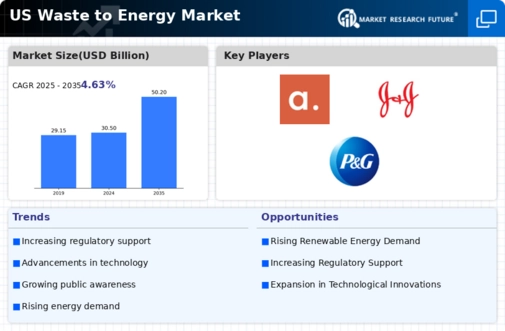Rising Energy Demand
The increasing demand for energy in the United States is a primary driver for the waste to-energy market. As population growth and urbanization continue, energy consumption is projected to rise significantly. The U.S. Energy Information Administration indicates that energy consumption could increase by approximately 10% by 2030. This growing demand necessitates alternative energy sources, making waste to energy an attractive option. The waste to-energy market is positioned to provide a sustainable solution by converting municipal solid waste into usable energy, thereby reducing reliance on fossil fuels. Furthermore, the integration of waste to energy facilities can help alleviate pressure on landfills, which are nearing capacity in many regions. Consequently, the waste to-energy market is likely to experience substantial growth as it addresses both energy needs and waste management challenges.
Environmental Regulations
Stringent environmental regulations are increasingly influencing the waste to-energy market in the United States. The U.S. Environmental Protection Agency (EPA) has established guidelines aimed at reducing greenhouse gas emissions and promoting sustainable waste management practices. These regulations often mandate the reduction of landfill waste, thereby creating a favorable environment for waste to energy projects. In 2025, the EPA reported that approximately 35% of municipal solid waste was diverted from landfills through recycling and waste to energy processes. This regulatory framework not only encourages the development of waste to energy facilities but also enhances public perception of waste management practices. Consequently, the waste to-energy market is likely to thrive as it aligns with environmental goals and contributes to a circular economy.
Technological Innovations
Technological innovations are transforming the waste to-energy market, enhancing efficiency and reducing costs. Advances in gasification, anaerobic digestion, and combustion technologies are enabling more effective conversion of waste into energy. For instance, recent developments in anaerobic digestion have improved biogas production rates, making it a more viable option for energy generation. In 2025, the waste to energy sector is expected to witness a 15% increase in energy output due to these technological advancements. Moreover, the integration of smart technologies and data analytics is optimizing operational efficiency in waste to energy facilities. As these innovations continue to evolve, the waste to-energy market is likely to attract more investments and partnerships, further driving growth and sustainability.
Public-Private Partnerships
Public-private partnerships (PPPs) are emerging as a vital driver for the waste to-energy market in the United States. These collaborations between government entities and private companies facilitate the development and financing of waste to energy projects. By leveraging public resources and private expertise, PPPs can enhance project viability and reduce financial risks. In 2025, several states have initiated PPPs to establish new waste to energy facilities, which are projected to generate over 500 MW of renewable energy. This collaborative approach not only accelerates project timelines but also fosters innovation in waste management solutions. As the waste to-energy market continues to evolve, the role of PPPs is likely to expand, creating a more robust framework for sustainable energy generation.
Government Incentives and Funding
Government incentives and funding play a crucial role in the expansion of the waste to-energy market. Federal and state governments in the U.S. have implemented various programs to promote renewable energy sources, including waste to energy. For instance, the Investment Tax Credit (ITC) and the Production Tax Credit (PTC) provide financial support for renewable energy projects. In 2025, the federal government allocated approximately $1 billion to support waste to energy initiatives, which is expected to stimulate investment in this sector. These financial incentives encourage private sector participation and innovation, leading to the development of more efficient waste to energy technologies. As a result, the waste to-energy market is likely to benefit from increased funding, which can enhance project feasibility and accelerate the transition to sustainable energy solutions.














Leave a Comment